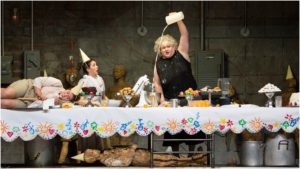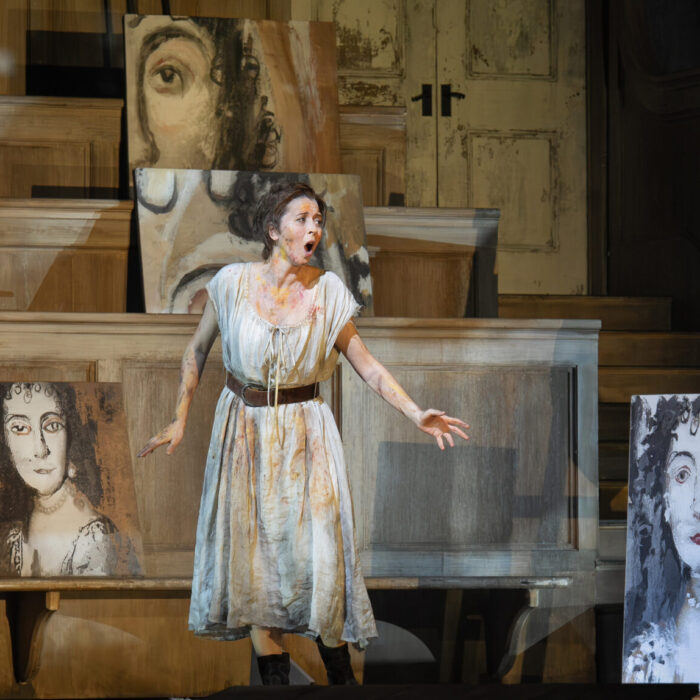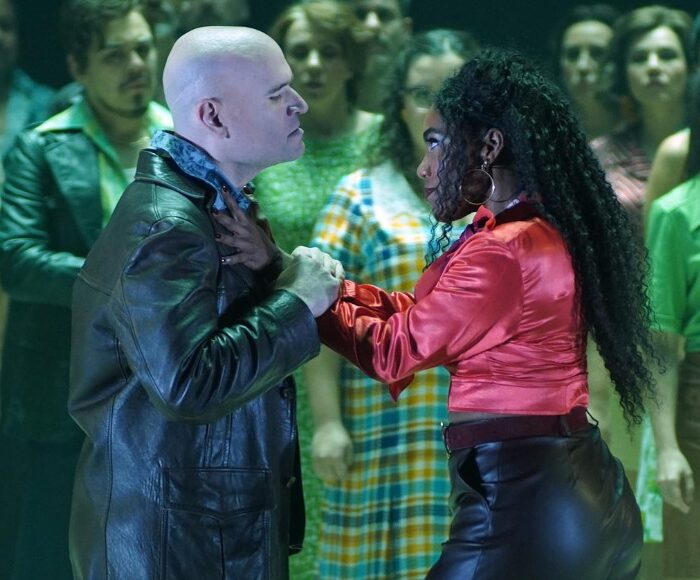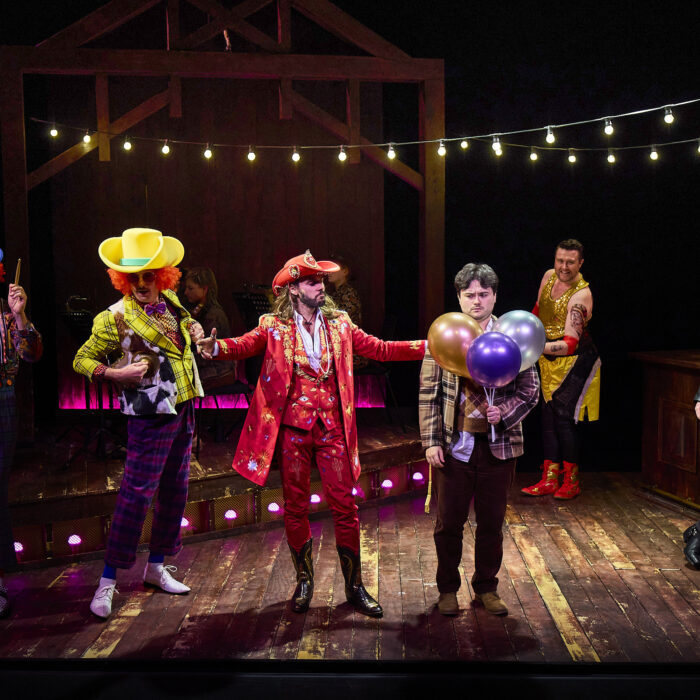
Metropolitan Opera 2017-18 Review – Hansel and Gretel: Lisette Oropesa & Co. Deliver One of Season’s Finest Performances
By David SalazarThis review is for the performance on Dec. 22, 2017.
We’re going to change things up a bit for this review. I don’t enjoy writing in the first person for this kind of article, but “Hansel and Gretel” is an extremely personal experience for me. It was the first opera I ever saw in my life at the age of 10. I still have faint recollections of how that first operatic moment would resonate throughout the years, even if it didn’t fatefully prove to be the deciding factor in ultimately being here and writing this review.
I’ve heard snippets of the Humperdinck opera since, but never in its entirety. Friday night’s performance at the Met was my first in nearly 20 years.
And I couldn’t help but feel the magic all over again.
Hunger for All
Richard Jones’ production is not new, dating back to 2007, but it feels as relevant as ever. As the main curtain reveals a dish with utensils set against a grey background, we can already feel a grim wave come over us. The motif will develop over the course of the night with subsequent reveals of the dish curtain featuring first a red stain and eventually a cracked version, emphasizing the hardship and danger of the world of its principal characters.
The sets themselves work to explore this hardened world. Hansel and Gretel’s beige colored house almost makes them blend in with their surroundings, its sterile color palette matching that of their respective clothes. The fact that it is so tiny and cramped and that the black space around it is so prominent only adds to this sense of imprisonment for these poor children. No jovial tune could overpower the sense of foreboding that this visual anticipates. And yet there is still a sense of homeliness and safety in this space, crammed as it may seem.
Things only get more unsettling when we move on to the second act and are faced with the “forest,” a long corridor filled with surreal characters that wouldn’t look out of a place in a Buñuel movie. From a fish butler to an ugly Sandman to the strange cooks with their oversized heads, it feels both fascinating and dangerous all the same. Treepeople hang around the space, their very existence another source of emotional confusion. In all, Jones communicates that the world may be fun and apt to explore, but it is also potentially dangerous, filled with many variable factors we simply can’t anticipate.
The ensuing sets feature a massive mouth cutout from a curtain, its expansive red aggressive and blinding for the viewer. And when that curtain finally rises we find ourselves at the apotheosis of all these themes we have seen colliding – a metallic, cold, oppressive abode that belongs to the famed Witch.
Jones takes on this journey through diverse spaces, each more threatening than the last until eventually, the source of greatest danger becomes the place where heroes are born and the good beats out the bad.
This level of ambiguity translates into the tone of the characters themselves, Jones allowing his gifted singing actors to ham it up as much as they want, but still maintaining a sense of dramatic stakes. Eric Einhorn, who directed this revival, does an expert job in ensuring this balance is maintained.
A Heroine is Born
Perhaps no one did a more fantastic job at playing to this tonal flexibility than Lisette Oropesa, her entire interpretation walking this line beautifully. Physically she was fully committed to arguably the most demanding of roles in this particular opera. We always felt she was a young girl just from looking at her. From her extremely acting facial expressions to her prancing about, even in the darkest of times. Seeing her fool around while the witch was attempting to control her elicited a tremendous amount of laughs. Ditto for her breaking out into a dance throughout as well, constantly playing with either of her Hansels. She was the inciter, the spark that lit the fire between the sibling relationship, thus making her the perfect hero for the story.
Vocally the soprano thinned her lyric soprano somewhat to transform into Gretel. It was nimbler, certainly less potent in its feel, but no less effective. That, of course, didn’t mean she was hiding away her vocal tools, as one could sense a growing weight throughout the evening as Gretel asserted herself into the hero of the story. The soprano has an astonishingly wonderful technique that is unrivaled at this moment and her ability to display such range of characterization only added to the support that she is an artist to be treasured.
Two Distinct Hansels
The role of Hansel was sung by two distinct artists on this night, both with decidedly different takes on the character. Tara Erraught kicked off the night as expected, her interpretation of one of her signature roles that of a boisterous child. While he played along with his sister, he was less refined, more clumsy and even a bit more aggressive. Erraught’s precise accenting of consonants only emphasized this, though she did showcase a wide range of tenderness in the second act, her mezzo smooth and silky.
After the intermission, it was announced that Erraught was unwell and would be unable to finish out the performance. Ingeborg Gillebo stepped in, six days earlier than her scheduled performance. From the outset it was clear her interpretation was wildly different, her Hansel coming off as an older and more mature. In some ways her interpretation made Hansel more in line with Gretel’s stronger personality, giving a sense of unity to their eventual success together. But inversely, because of Oropesa’s electric stage presence, Gillebo’s less contrasted take made her blend in more. The contrast that Erraught brought added tension to the relationship, giving it somewhere to grow by the end of the night. Gillebo’s more poised vocal and physical approach to the character made it seem that Hansel would not evolve further as a character, and he didn’t. Of course, this could be the result of Gillebo not getting the full evening to develop her character.
Love to Hate and Hate to Love
Gerhard Siegel was a scene stealer as the Witch, his brief scene filled with tons of flavor. He ate into every word, every phrase, every consonant with relish that it was impossible not to feel overwhelmed by his presence. At one point, he soared up to a climactic high note that stopped the performance in its tracks, the audience breaking into raucous applause to meet him. He strutted about uncomfortably, playing up the comedic aspects of the witch, making his interpretation all the more assured and impactful in its grotesqueness. In a production that plays up the ambiguity of a dangerous world, his character was at its heart – clearly a dangerous villain, but a loveable and exciting one nonetheless.
As Gertrud and Peter, Dolora Zajick and Quinn Kelsey layered the drama as the two parents that felt like full-blooded beings. They only really get one scene to explore the depths of these two irresponsible beings, but they imbued them with so much humanity that you felt their tragedy as much as the titular characters’. There was no doubt that Zajick’s Gertrude was an imposing woman, even a strict one, her voice booming and bellowing in sections where she chides the kids of their misdeeds. She even took some pauses in the middle of phrases to add greater accentuating to some notes. And yet, her interactions were not those of an abusive mother but of a struggling woman. Seeing the pot break, she storms out into vicious musical phrases; Zajick threw herself into the music, but one never felt she was a monster, but that something valuable had been ripped from her and she was just responding out of frustration.
Kelsey’s Peter was also multi-layered. Peter’s introduction is the polar opposite of Gertrud’s. She enters in rage, he arrives on the scene in playful song. And yet, there is a sense that he might be somewhat inebriated and somewhat of a child. He sits on the floor and is more interested in playing around with his wife than taking her seriously. When she goes too far in attacking his pride, he gets up to hit her, a very revealing moment in the relationship and reminder that he is far from a saint himself. She stops him in his tracks, but the “damage” has already been done to his character. Kelsey, who sang gloriously throughout with honeyed tone and some of the lushest legato we’ve heard at the Met this season, could not butter it up any longer. And that just made him all the more fascinating.
Wagnerian Richness
Humperdinck may have been one of Wagner’s protégés but no one would ever go so far as to mention his music in the same breath as that of the Bayreuth master. And yet, Maestro Donald Runnicles’ exquisite handling of this score made it feel as sublime as the best of Wagner’s music. Everything was exquisitely refined. Everything. Personally, this was best represented in the extensive coda that ends the second act, its strings constantly swelling and rising with increasing wonder. The music moved toward its inevitable climax, but he allowed for that ascent to feel ever-expansive; all I could do was ask for more and more music. For this glorious passage to continue on and on.
It was precisely this moment that brought me back to that day as a 10-year-old discovering the art form for the very first time. My eyes moistened.


